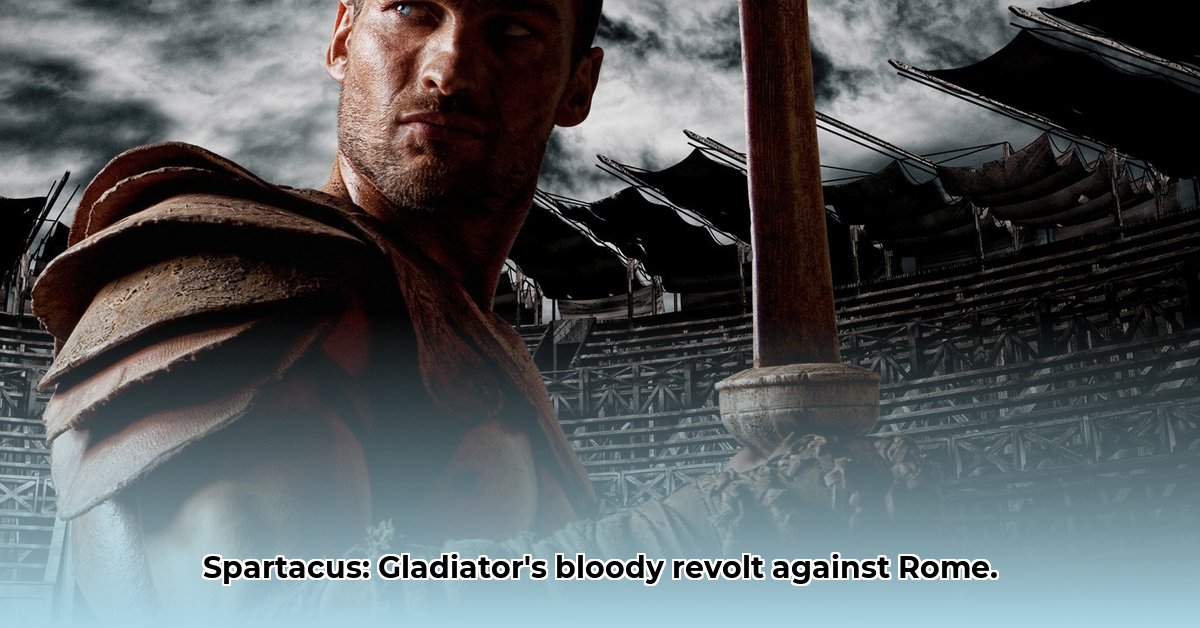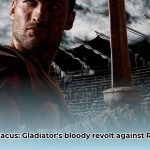Who was Spartacus? More than just a gladiator, he was the Thracian leader of a massive slave revolt against the Roman Republic – an underdog story marked by incredible battles and profound social impact. This article explores the depths of his rebellion, examining his military strategies, the revolt’s ultimate failure, and its lasting legacy on Roman society and beyond. Discover the key figures, the brutal realities of slavery, and why Spartacus continues to inspire today. For context on Roman military strategies, learn more about great Roman generals.
Spartacus: The Gladiator Who Challenged Rome
The Spark of Rebellion: Unearthing the Origins of a Slave Uprising
The Spartacus story isn’t just about one man; it’s about a system ripe for revolt. It begins not with a grand revolutionary plan, but with a desperate act of defiance. In 73 BC, Spartacus, a Thracian gladiator, along with approximately 70 fellow gladiators, escaped from a gladiatorial school in Capua. This wasn’t a meticulously planned uprising. It was a gamble fueled by the instinct for survival. This seemingly small act, however, ignited a firestorm that would rage across Italy for two years.
From Runaway Slaves to a Rebel Army
The Explosive Growth of the Resistance
The initial band of escaped gladiators didn’t remain small for long. Their numbers swelled as enslaved people from the countryside joined their ranks. This diverse army, estimated to have numbered over 70,000 at its peak, wasn’t a chaotic rabble. It was a well-organized fighting force. Spartacus, leveraging his military experience, instilled discipline and formulated effective tactical strategies. Rome was caught off guard by the rebels’ numbers, organization, and unexpected strength.
Military Genius: Clever Tactics and Stunning Victories
Analysis of Military Strategies and Innovations
Facing the daunting task of challenging the Roman military machine, Spartacus employed innovative tactics that consistently outmaneuvered his opponents. Rather than engaging in direct, head-on battles, he favored guerrilla warfare, utilizing hit-and-run attacks and exploiting the terrain to his advantage. These early victories were stunning. Rome, accustomed to military dominance, struggled to comprehend how a slave army could consistently defeat its legions.
One notable example occurred early in the revolt. The Roman praetor, Gaius Claudius Glaber, trapped Spartacus and his initial band of followers on Mount Vesuvius, believing he could starve them into submission. Spartacus, however, ordered his men to weave ropes and ladders from the mountain’s abundant vines. They then stealthily descended the cliffs on the far side of the mountain, outflanking Glaber’s unsuspecting forces and routing them. This victory provided the rebels with much-needed weapons and supplies, while simultaneously boosting their morale and attracting more recruits.
Cracks in the Ranks: Internal Divisions and Leadership Challenges
Examining the Impact of Disunity on the Rebellion’s Trajectory
Despite initial successes, the rebellion was plagued by internal divisions. Disagreements arose between Spartacus and other leaders, specifically Crixus, over strategy and goals. While Spartacus favored escaping Italy and leading his followers to freedom, Crixus desired to continue raiding Roman territories. These disagreements ultimately led to a split in the rebel forces, weakening their overall strength.
In 72 BC, Crixus led a large contingent of Gauls and Germans away from Spartacus’s main army. This splinter group was subsequently intercepted and destroyed by a Roman army under the command of Quintus Arrius, with Crixus himself killed in battle. This defeat not only reduced the rebels’ overall numbers, but also highlighted the vulnerability caused by their internal divisions.
The Final Showdown: Crassus’s Ruthless Victory
Highlighting Turning Points and Strategic Errors in the Decisive Battles
Marcus Licinius Crassus, a wealthy and ambitious Roman politician, was entrusted with the task of crushing the rebellion. Crassus assembled a large, well-trained army and implemented a strategy of relentless pursuit and brutal discipline. After a series of hard-fought battles, Crassus cornered Spartacus’s remaining forces in Bruttium, in southern Italy, in 71 BC. Desperate to escape, Spartacus attempted to cross the Strait of Messina into Sicily, but his Cilician pirate allies betrayed him, leaving him trapped.
The final battle was a desperate affair. Spartacus, knowing the end was near, reportedly killed his own horse before the battle, declaring that if he won, he would have plenty of horses, and if he lost, he would not need one. He fought fiercely, attempting to reach Crassus himself, but was ultimately cut down. The remaining rebels were decisively defeated.
A Brutal Aftermath and a Legacy of Resistance
Modern Lessons from Ancient Conflicts and Acts of Defiance
The aftermath of the rebellion was brutal. Thousands of captured rebels were crucified along the Appian Way, a gruesome spectacle designed to deter future uprisings. Despite its bloody end, the Spartacus rebellion became a symbol of resistance against oppression. The rebellion also exposed the inherent instability caused by Rome’s reliance on slave labor, a social problem that contributed to the Republic’s later decline. Understanding this pivotal moment in history offers valuable insight into enduring themes of power, freedom, and human resilience.
Who Was Affected by Spartacus’s Rebellion? Long-Term Effects
Delving into Stakeholder Impacts
The impact of Spartacus’s rebellion resonated throughout Roman society, both immediately and in the long term.
| Stakeholder Group | Short-Term Impact | Long-Term Impact |
|---|---|---|
| The Roman Government | Severe military setbacks, political instability, and significant loss of life. | Increased social unrest, some reforms to slave management, a strengthening of the military, and a heightened awareness of the potential for slave rebellions. |
| The Enslaved Population | Brief hope and temporary freedom for many; horrific casualties. | Limited improvements in conditions for some slaves, but the fundamental system of slavery remained largely unchanged. |
| The Roman Elite | Fear, anxiety, disruption of agricultural production, and political instability. | Increased reliance on military strength to maintain control, and a growing awareness of the potential dangers of a large slave population. |
| Italian Landowners | Damage to property, disruption of agricultural production, and fear of slave uprisings. | Increased investment in security measures, and a shift toward more diversified labor practices in some regions. |
| Roman Military | Initial defeats and demoralization, followed by a resurgence under Crassus. | Increased prestige for Crassus and Pompey, and a renewed focus on military discipline and effectiveness. |
| Future Slave Revolts | Inspiration and a model for resistance. | Although no other slave revolt reached the scale of Spartacus’s, the fear of similar uprisings remained a constant concern for the Roman authorities. |
| Modern Political Thought | Symbol used by Marxists/Socialists for their political goals | Interpretations of Spartacus helped shape modern thinking about social justice, inequality, and the struggle for liberation. |
| Historians and Researchers | Limited and biased historical accounts. | Ongoing debates about the motivations, strategies, successes, and ultimate significance of the rebellion. |
Spartacus: Then and Now – Understanding the Revolt Through Historical Lenses
Interpretations of the Conflict
Modern scholarship seeks to understand Spartacus’s rebellion within its specific historical context. While earlier historians often romanticized Spartacus as a champion of liberty or a proto-communist revolutionary, contemporary researchers strive for a more nuanced understanding, focusing on the complexities of Roman society and military power. This perspective is crucial for accurately assessing the rebellion’s true significance. The enduring legacy of Spartacus lies in what his story can teach us about power, freedom, and the constant struggle to overcome oppression.
How Did Spartacus’s Military Strategies Contribute to the Initial Success of the Revolt?
Deciphering Tactical Decisions
Key Takeaways:
- Spartacus expertly employed guerrilla warfare, leveraging the terrain and his knowledge of Roman tactics to his advantage.
- His adaptable strategies, shifting between hit-and-run attacks and pitched battles, kept the Romans off balance.
- Psychological warfare, including displays of brutality and strategic retreats, demoralized the enemy and attracted new followers.
The Art of the Ambush: Guerrilla Warfare
How Terrain Influenced Outcomes
A key element of Spartacus’s initial success was his masterful use of guerrilla tactics. Unlike the Romans, who relied on large-scale, highly organized legions, Spartacus understood the advantages of mobility and surprise. He knew the Italian landscape well, using it to his advantage by choosing battlegrounds that negated the Roman advantages in numbers and training. Sudden, devastating attacks from hidden positions, followed by quick retreats into rugged terrain, exhausted the enemy and kept them constantly on edge. This unconventional approach caught the Romans completely off guard, leading to numerous early defeats.
Adaptability: Shifting Sands of Strategy
Assessing Strategic Flexibility
Spartacus wasn’t limited to a single approach. He was a master of adaptation, constantly adjusting his tactics based on the enemy’s response and the available terrain. He didn’t just rely on hit-and-run skirmishes. When opportunities presented themselves, he engaged in larger, more conventional battles, demonstrating tactical ingenuity and a shrewd assessment of his enemies’ weaknesses. This flexibility kept the Romans guessing, constantly forcing them to react and preventing them from developing a consistent counter-strategy. His ability to shift gears as needed proved crucial to his early victories.
The Power of Fear: Psychological Warfare
The Impact of Morale on Warfare
Beyond battlefield maneuvers, Spartacus skillfully employed psychological warfare. The Romans were shocked by the brutality of some of the rebels’ actions, which were designed to intimidate and demoralize them. The rebels weren’t just a ragtag group of slaves; they were a force capable of inflicting devastating losses and inspiring fear. Strategic retreats, carefully orchestrated to appear more like cunning maneuvers than failures, further chipped away at Roman morale. This psychological erosion was as potent a weapon as Spartacus’s swords and spears.
Unity (however fleeting): A Multitude of Motivations
Socio-Political Factors and Unity
Spartacus’s army was incredibly diverse, composed of individuals from different nationalities with varying motivations. A shared desire for freedom, vengeance, and a better life fueled their early success. This unity was temporary, and internal divisions would contribute to their downfall.
The Roman Response: Underestimation and its Consequences
Analyzing the Initial Response of Rome
Rome’s initial response to the uprising was characterized by underestimation. They underestimated both the size and the combat effectiveness of the “slave rebellion.” Their initial strategy was disorganized and reactive, leading to a string of defeats that further demoralized the Roman legions and boosted the confidence of Spartacus and his followers. This initial failure, combined with Spartacus’s military brilliance, explains the revolt’s early astonishing successes.
Spartacus’s Revolt: Impact on Roman Social Structures
Socio-Economic Restructuring
Key Takeaways:
- The sheer scale of Spartacus’s revolt, involving tens of thousands of slaves, exposed deep fault lines and contradictions within the Roman slave system.
- The rebellion’s success, though ultimately short-lived, challenged Roman authority and sparked significant social unrest and fear among the Roman elite.
- Spartacus’s Revolt had both immediate and long-term impacts, influencing slave management policies and indirectly shaping the rise of powerful military figures who exploited the crisis for their own political gain.
The Spark Ignited: The Outbreak and Early Successes
Events Leading to Revolt
The year 73 BCE marked the beginning of a rebellion unlike any other in Roman history, a moment when the exploited turned on their masters and brought the empire to its knees. Approximately 70 gladiators, escaping their brutal lives in the Ludus Magnus in Capua, ignited a conflict that would engulf southern Italy. Led by Spartacus, a Thracian gladiator known for his military skills, the rebels achieved early successes that were both surprising and terrifying to the Roman elite. Their initial strength, though seemingly insignificant, quickly swelled to thousands as enslaved people from across the region flocked to their banner. This indicated the widespread discontent simmering beneath the surface of Roman society.
Their early victories weren’t just about numbers. Spartacus proved to be a skilled tactician, employing both conventional and guerrilla warfare against the Roman legions sent to quell the uprising. His army transformed into a formidable fighting force, repeatedly defeating Roman forces dispatched against them.
Challenging Roman Authority: The Revolt’s Military and Social Impact
Examining Political Repercussions and Changes
The revolt wasn’t just a military campaign; it was a social earthquake that exposed the vulnerabilities of Roman society. For two years, Spartacus’s forces controlled vast swathes of Southern Italy, disrupting established economic and social orders. The economic impact on Rome was significant. Agricultural estates were ravaged, trade routes disrupted, and the wealth concentrated in the hands of the Roman elite was threatened.
The Crushing Blow: Defeat and its Aftermath
Consequences of Defeat and Slave Retribution
The revolt was finally crushed in 71 BCE. Marcus Licinius Crassus, a powerful Roman general, implemented a brutal military strategy focused on ruthlessly suppressing the rebellion. Although the exact casualties remain uncertain, the end of Spartacus’s rebellion resulted in the deaths of tens of thousands of slaves. The aftermath was brutal. Crassus crucified thousands of captured rebels along the Appian Way, a dramatic display meant to discourage any future uprisings.
Lasting Shadows: Spartacus’s Revolt and Its Long-Term Consequences
Implications for The Future and The Effects of Slave Rebellions
While the overall effect of Spartacus’s Revolt is debated, it’s clear that it had long-term repercussions for Roman society. While slavery continued to be a cornerstone of the Roman economy, the uprising prompted a reevaluation of slave management practices. The Romans tightened control of their slaves, implementing stricter regulations and increasing security measures to prevent future uprisings.
The rise of Crassus was also directly linked to his success in quelling the revolt. This highlights how the crisis created opportunities for ambitious individuals to gain power and influence. His actions, along with those of other powerful figures like Pompey, ultimately contributed to the weakening of the Roman Republic, paving the way for the rise of the Roman Empire.
Interpretations and Debates: Understanding Spartacus’s Legacy
Historical Subjectivity and Viewpoints
The motivations of Spartacus and the true meaning of his revolt remain subjects of scholarly debate. Was he solely focused on escaping slavery, or did he harbor revolutionary ambitions? These ongoing debates underscore the challenges of interpreting historical events based on ancient accounts, which are often limited and subject to bias.
The Spartacus Rebellion: Economic and Political Pressures in Late Republican Rome
Analysing the Precursors to the Revolution
Key Takeaways:
- The Spartacus Rebellion (73-71 BC) was a major slave uprising in the Late Roman Republic, exposing deep-seated social and economic inequalities.
- The revolt’s initial successes highlighted the vulnerability of a system heavily reliant on slave labor.
- Historians continue to debate Spartacus’s motivations: was he a freedom fighter or simply a pragmatic rebel leading a desperate uprising for survival?
The Seeds of Rebellion: Economic Hardship and Social Inequality
Socio-Economic Context of Slavery in the Roman Empire
The late Roman Republic was characterized by extreme wealth inequality. A small elite controlled vast estates, latifundia, which were worked by huge numbers of slaves. These slaves, often prisoners of war or victims of debt, endured brutal conditions, lacking basic rights and subject to their masters’ whims. This created a volatile social climate, where the potential for rebellion was ever-present. The Spartacus Rebellion ignited this latent unrest, transforming it into a major crisis for the Republic.
Spartacus: Leader or Opportunist?
Examining Leadership Qualities
Ancient historians present differing portraits of Spartacus. Some portray him as a charismatic leader, fighting for the freedom of the oppressed. Others depict him as a ruthless opportunist, exploiting Rome’s military weaknesses and the desperation of the slaves for his own gain. The truth likely lies somewhere in between. His military prowess is undeniable; he orchestrated a series of stunning victories against Roman legions. However, his ultimate goals remain a matter of speculation. Did he envision a world without slavery, or was he simply seeking to lead his followers to safety and freedom?
The Military Campaign: A Tumultuous Struggle
Detailed Analysis of Key Events and Battle Outcomes
Spartacus’s initial successes were remarkable. The rebel army, drawn from the ranks of gladiators and slaves, rapidly grew in size. He implemented innovative military tactics, demonstrating his understanding of both Roman military strategy and the terrain. The rebels’ movements across the Italian peninsula spread fear and uncertainty throughout Roman society. However, this success was not sustainable in the long term. The Roman Republic, with its vast resources and manpower, eventually responded decisively, overwhelming the rebels through superior numbers and organization.
The Rebellion’s Impact: Political Upheaval and Consequences
Reviewing Political Impact and Long-Term Effects
The crushing defeat of The Spartacus Rebellion had significant political consequences for Rome. The rebellion exposed the instability inherent in a system heavily reliant on slave labor. The revolt contributed to the rise of ambitious Roman generals like Marcus Licinius Crassus, who capitalized on the crisis to enhance their own prestige and influence. Crassus’s victory over Spartacus served as a stepping stone for his later political ambitions. The events of that period contributed to the decline of the Republic, paving the way for the Roman Empire.
The Legacy of Spartacus: Symbol of Resistance
Spartacus in Contemporary Culture and Political Use
Despite its tragic end, The Spartacus Rebellion remains a potent symbol of resistance against oppression and injustice. The story of Spartacus has been recounted and reinterpreted throughout history, often reflecting the concerns and values of different eras.















